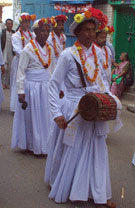The Newar Civilization
 "Now a days the term Nepalese has a far wider significance, indeed almost a changed meaning, but when we speak of Nepalese civilization, we can only mean Newar civilization"
"Now a days the term Nepalese has a far wider significance, indeed almost a changed meaning, but when we speak of Nepalese civilization, we can only mean Newar civilization"
- David Snellgrove
'Shrines and Temples of Nepal'
Arts Asiatique
VIII,I,1961 Page # 3
The above quote by a foreigner tells us much about the Newar and Nepalese Civilization.
Today, the term Newar (or Newah) stands for a group of people. However, if we see the Nepalese history, we'll find that the terms 'Newar' and 'Nepal' have been used interchangeably. The term 'Nepal' is first found in 'Atharva Parishista' (4th Century B.C.). The term 'Kirat Pradesh' can be found in earlier documents. According to this, it is understood that the term 'Kirat' not only stands for Rai, Limbu or Sunuwar but also stands for all the people living here at that time, including the Newars..
The term 'Swasti Naipalavya' is inscribed in three inscriptions of Tistung. (One dated 512 AD & other two dated 607 AD). 'Naipalavya' means the Nepals i.e. plural form of Nepal. (Here, 'Nepal' has been used as the people living in a particular place.). The term 'Newar' is derived from this very term 'Nepal'..
According to the researches, Indus Valley civilization is the ancient Vedic civilization and it evolved before the Aryans came to India. Newar civilization is believed to be much older than the Indus civilization. The nature and geography of Nepal prove this fact. (Pradhan, Bhuwan Lal, Nepalko Itihas ra Sanskriti ka kehi Pakshya, Kathmandu : NRPP, p. 129) The Newar civilization began in 6th century B.C. (Bista, Dor Bahadur, The people of Nepal, Kathmandu: Ratna Pustak Bhandar, p. 17). The Newar civilization evolved much earlier than the period of the Buddha and the Guptas. The temples and other monuments in Nepalmandala prove this fact without any doubt. (Malla K. Sundar, Newah Mhaseeka, Kathmandu: Malla, p.20).
The written history of Nepal begins with the dynasty of Gopal (Sa Poo) and Mahispal (Mey Poo). The Gopali people are still found in Tistung, Palung and near villages. According to the research done on Gopali people by Dr. Chunda Bajracharya, she has concluded that the Gopali people are still following Newar culture and language. So the Gopali people are the Newars..
his clarifies that the Newars are the first rulers of Nepal. Since then, the Newars are still living here. However, many immigrants came to Nepal mandal from different places in different time and followed Newar language & culture and became Newars. This brought cultural and lingual diversity among the Newars.